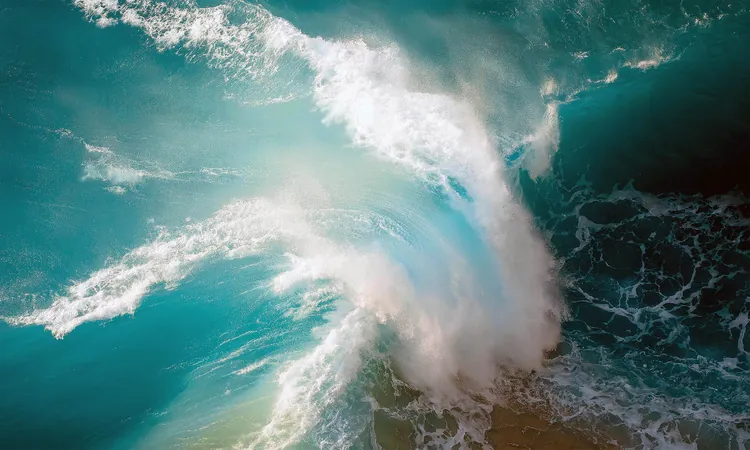
Unveiling the Enigma of Rogue Waves: The Most Remarkable Giant Yet
2025-07-22
Author: Lok
The Monstrous Rogue Wave Phenomenon
Picture this: you're sailing on the vast ocean, navigated by the familiar rhythm of rolling waves. Suddenly, a titanic wall of water—two to three times taller than the usual surf—surges upward and crashes dangerously. This is a rogue wave, a phenomenon that has baffled sailors with its immense power and unpredictability.
For centuries, mariners spun tales of these ocean giants, tales that many deemed mere myth... until the Draupner wave shattered that notion in 1995. This behemoth, soaring to an astonishing height of 85 feet, struck an oil platform off Norway’s coast, casting aside any doubt about the existence of rogue waves.
Introducing the Ucluelet Wave: Nature's Most Extreme Rogue Wave?
Fast forward to a more recent discovery off Vancouver Island, where a rogue wave known as the Ucluelet wave was recorded at 58 feet. Though it may seem shorter than the Draupner, its extreme proportionality—reaching over three times higher than surrounding waves—has left researchers, including physicist Johannes Gemmrich, contemplating its significance in rogue wave studies.
Rogue Waves: A Hidden Danger of the Sea
Though the Ucluelet and Draupner waves didn’t wreak havoc, history tells a different story. Many vessels that disappeared in the 1970s could have fallen prey to these monstrous waves. With climate change on the rise, the North Pacific is expected to see an increase in wave heights, raising concerns that records like Ucluelet’s may soon fall.
Demystifying Rogue Waves: Predictability vs. Chaos
Unlike the soft, rhythmic shore waves that lull beachgoers into complacency, rogue waves are the ocean’s unpredictable giants, capable of striking unexpectedly in calm waters. While typical waves are created by consistent wind patterns and the seafloor’s shape, rogue waves result from chaotic interactions between multiple waves converging at just the right moment.
Unlocking the Secrets in Antarctic Waters
In an expedition led by the University of Melbourne, scientists ventured to Antarctic waters, armed with innovative technology. Their research unveiled surprising connections between wind dynamics and rogue wave formation. Professor Alessandro Toffoli explained that during the “young” phase of waves, wind energy amplifies some waves while diminishing others, creating a chaotic environment conducive to rogue wave creation.
The Role of Nonlinear Effects and Energy Modulation
As waves grow, they interact in complex ways—peaks sharpen, and troughs flatten. This “nonlinear effect” can intensify waves far beyond what traditional models predict. To truly grasp the mystery of rogue waves, researchers are employing advanced fourth-order Stokes theory, which considers even more intricate interactions that can lead to these formidable giants.
Future of Rogue Wave Prediction
Scientists are optimistic about developing better predictive models for rogue waves. One promising method is crest-trough correlation, which identifies how closely wave crests relate to their neighboring troughs—essentially helping predict when the ocean might produce a rogue wave. By integrating existing weather data with these calculations, we could soon anticipate these natural phenomena more effectively.
The study, published in the journal Scientific Reports, highlights an exciting frontier in oceanography, emphasizing the importance of understanding rogue waves—not just for scientists, but for the safety of coastal communities and marine operations alike.


 Brasil (PT)
Brasil (PT)
 Canada (EN)
Canada (EN)
 Chile (ES)
Chile (ES)
 Česko (CS)
Česko (CS)
 대한민국 (KO)
대한민국 (KO)
 España (ES)
España (ES)
 France (FR)
France (FR)
 Hong Kong (EN)
Hong Kong (EN)
 Italia (IT)
Italia (IT)
 日本 (JA)
日本 (JA)
 Magyarország (HU)
Magyarország (HU)
 Norge (NO)
Norge (NO)
 Polska (PL)
Polska (PL)
 Schweiz (DE)
Schweiz (DE)
 Singapore (EN)
Singapore (EN)
 Sverige (SV)
Sverige (SV)
 Suomi (FI)
Suomi (FI)
 Türkiye (TR)
Türkiye (TR)
 الإمارات العربية المتحدة (AR)
الإمارات العربية المتحدة (AR)